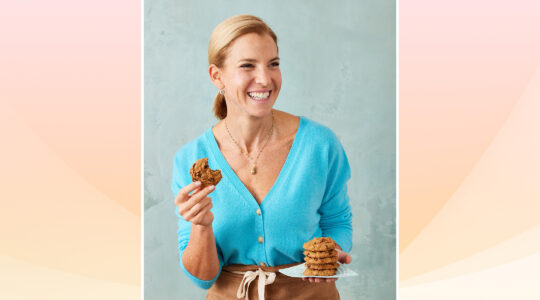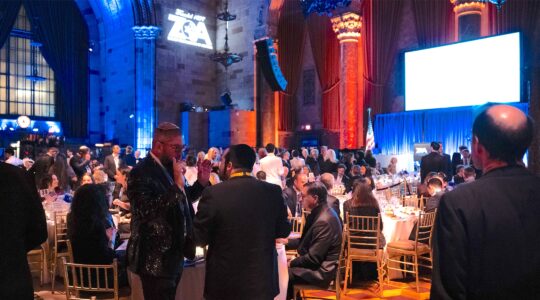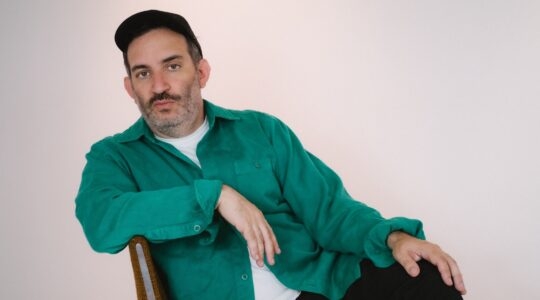Last fall, Isabella Malaga of Boca Raton, Fla., was introduced by her aunt to the children of families in a homeless day center in nearby Delray Beach. When it came time to choose a bat mitzvah project earlier this year, Isabella already knew what she wanted to do.
“I saw this empty space [in the backyard of the center],” she said. “There was nothing on it, so I said I would like to build a playground. … I love the children there and it is fun to play with them.”
To raise the money, Isabella turned to Houses for Change, an arts-and-crafts program created four years ago by Mark Wasserman. A fellow congregant at B’nai Torah Congregation in Boca Raton, Wasserman also volunteers at the homeless day center, which is operated by Family Promise of South Palm Beach County.
Houses of Change asks youngsters to decorate a pre-scored flat box that opens into the shape of a house with a handle on top. Isabella said she sent the boxes to the approximately 70 families she invited to her bat mitzvah, along with a letter explaining her fundraising project and asking them to fill the boxes with their loose change. More than 50 of the boxes were returned (many of the guests sent checks) on the day of her bat mitzvah in May. A local bank sorted the change without charge.
“It came to about $2,000,” Isabella said of the amount raised.
She said that she then went to a local store to get a price on a swing set. But after explaining what it was for, the storeowner offered to donate it it along with the playhouse that came with it.
The money she raised was used to cover the playground with rubber mulch, which cushions children’s falls and minimizes dangerous playground impacts.
Kokie Dinnan, executive director of that Family Promise affiliate, which is located in a building donated by St. Vincent Ferrer Catholic Church, had nothing but praise for Isabella’s efforts. She said the playground has been a perfect addition for the children since it was dedicated in September.
“The best part,” said Isabella, “was seeing the kids play on it.”
Her rabbi, David Steinhardt, was so impressed with her accomplishment that he praised it in one of his High Holy Days sermons.
He later told The Jewish Week that he believes Houses for Change is such a “wonderful program” that he brought two of the houses with him to give to President Barack Obama for his daughters when he visited the White House for the annual Chanukah party.
“They are like homemade JNF boxes,” he said. “They remain present in a family’s life to remind them about homelessness. It’s an accessible mitzvah project that is meaningful because it makes a difference.”
Support the New York Jewish Week
Our nonprofit newsroom depends on readers like you. Make a donation now to support independent Jewish journalism in New York.
Dinnan said the families are at the center on weekends during the day and when the children are not in school in the summer. “We have the only sheltering program in South Beach County that addresses homelessness,” she said. “We serve about 16 families a year who have from one to six dependent children, and they stay an average of three to four months.”
Dinnan said local houses of worship in the area — including synagogues, churches, a mosque and a Baha’i temple — take turns housing the families and volunteers from those institutions prepare and serve them meals.
“Houses of Change has brought awareness of the families out there facing homelessness and it gave Isabella a tool to raise money for our playground,” she said. “It is also raising money for homelessness throughout the country, which is pretty amazing.”
Since its founding four years ago, more than 30,000 youngsters nationwide have decorated Houses of Change boxes and raised more than $400,000 for homeless shelters, food banks and other charities of their choice, according to Wasserman.
“It was inspired by our tradition of the tzedakah box,” he said. “The beauty of the program is that the money collected goes to whatever charity the organization decides.”
He said synagogues have ordered the boxes for their mitzvah day programs. Others have used them for Purim baskets — asking congregants to decorate the boxes and fill them with cake and candy to give to friends, and then asking recipients to collect change in the empty box to raise money for a synagogue project.
“They are also a natural fit for Passover and Chanukah,” Wasserman said.
For about 75 Manhattan children ages 3 to 8, the boxes were used as a tool last month to learn about Sukkot, according to Sari Laufer, associate rabbi of Congregation Rodeph Sholom on the Upper West Side.
An hour or two before the holiday began, the children were given the boxes to decorate at the synagogue.
“Sukkot is a time for teaching about hunger and homelessness and vulnerability,” she said. “When I teach about Sukkot I teach about dwelling in a sukkah and what it means to be vulnerable and open to the elements. Living in an urban area, we are not real outdoor people. But the sukkah gives the children an idea of what it means when we say that some people don’t have a home to go back to.”
“Homes for Change gave the children something tangible to take home, and it connected them to something at the synagogue that is related to these issues,” Rabbi Laufer observed. “I don’t know how much they were able to take in at the moment. My hope is that when they got home they had a discussion with their parents about the tzedakah box and why they decorated it. I see it as a teaching moment for families.”
She said her congregation, which numbers 1,700 households, conducts a food drive on Yom Kippur and a fundraising drive in the fall for direct service organizations in the community, including Dorot, West Side Campaign Against Hunger and Urban Pathways.
Support the New York Jewish Week
Our nonprofit newsroom depends on readers like you. Make a donation now to support independent Jewish journalism in New York.
“Every kid who decorated a box got a letter that encouraged them to collect change,” Rabbi Laufer said. “We will soon be asking them to bring the boxes back — or the change they collected — and put that money towards the fundraising drive.”
The New York Jewish Week brings you the stories behind the headlines, keeping you connected to Jewish life in New York. Help sustain the reporting you trust by donating today.




